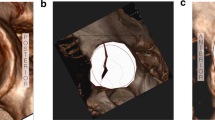Abstract
Purposes
The objective of this work is to explore the morphological characteristics of the acetabular posterior column using digital technology, in order to develop anatomical plates for internal fixation of acetabular posterior column fractures.
Materials and methods
Three-dimensional reconstruction models of the pelvis were developed from computed tomography scan data of 111 adult patients. From them, the diameter (D) of the femoral head, three approximate arcs along the acetabular posterior column plate path with corresponding radius of curvature \(\hbox {R}_{1}, \hbox {R}_{2}\) and \(\hbox {R}_{3}\), as well as an angle \(\alpha \) were measured. A statistical analysis was used to determine the most feasible method of designing anatomical plates according to the data.
Results
The statistical analysis results showed that \(\hbox {R}_{1}, \hbox {R}_{2}\) and \(\hbox {R}_{3}\) had no correlations with D, and they also exhibited no statistically significant differences between genders. By examining the correlations between four morphological parameters of the acetabular posterior column, the results showed \(\hbox {R}_{2}\) increased along with \(\hbox {R}_{1}, \alpha \) was inversely proportional to \(\hbox {R}_{1}\) and \(\hbox {R}_{2}\), and \(\hbox {R}_{3}\) was independent with little variation. Taking \(\hbox {R}_{1}\) as the reference, the data were divided into three groups and three types of anatomical plates were designed according to the three groups of data.
Conclusion
The anatomical structure of the acetabular posterior column exhibits great individual differences. Anatomical plates designed in this study have higher accuracy than those conventional ones, which is helpful to the quality of fracture reduction and reduce the operation difficult. Meanwhile, they also can be conveniently used in clinic.







Similar content being viewed by others
References
Matta JM (1996) Fractures of the acetabulum: accuracy of reduction and clinical results in patients managed operatively within three weeks after the injury. J Bone Joint Surg Am 78:1632–1645
Mehin R, Jones B, Zhu Q, Broekhuyse H (2009) A biomechanical study of conventional acetabular internal fracture fixation versus locking plate fixation. Can J Surg 52:221–228
Murphy D, Kaliszer M, Rice J, McElwain JP (2003) Outcome after acetabular fracture: prognostic factors and their inter-relationships. Injury 34:512–517
Mears DC, Velyvis JH, Chang CP (2003) Displaced acetabular fractures managed operatively: indicators of outcome. Clin Orthop Relat Res 407:173–186
Briffa N, Pearce R, Hill AM, Bircher M (2011) Outcomes of acetabular fracture fixation with ten years’ follow-up. J Bone Joint Surg Br 93:229–236
Tile M, Helfet D, Kellam J (2003) Fractures of the pelvis and acetabulum, 3rd edn. Lippincott Williams & Wilkins, Philadelphia
Shen F, Chen B, Guo Q, Qi Y, Shen Y (2013) Augmented reality patient-specific reconstruction plate design for pelvic and acetabular fracture surgery. Int J Comput Assist Radiol Surg 8:169–179
Xin-wei L, Shuo-gui X, Chun-cai Z, Qing-ge F, Pan-feng W (2010) Biomechanical study of posterior wall acetabular fracture fixation using acetabular tridimensional memory alloy-fixation system. Clin Biomech (Bristol, Avon) 25:312–317
Mayo KA (1994) Open reduction and internal fixation of fractures of the acetabulum. Results in 163 fractures. Clin Orthop Relat Res 305:31–37
Letournel E, Judet R, Elson RA (1993) Fractures of the acetabulum, 2nd edn. Springer, New York
Kaempffe FA, Bone LB, Border JR (1991) Open reduction and internal fixation of acetabular fractures: heterotopic ossification and other complications of treatment. J Orthop Trauma 5:439–445
Wright R, Barrett K, Christie MJ, Johnson KD (1994) Acetabular fractures: long-term follow-up of open reduction and internal fixation. J Orthop Trauma 8:397–403
Templeman DC, Olson S, Moed BR, Duwelius P, Matta JM (1999) Surgical treatment of acetabular fractures. Instr Course Lect 48:481–496
Hadley NA, Brown TD, Weinstein SL (1990) The effects of contact pressure elevations and aseptic necrosis on the long-term outcome of congenital hip dislocation. J Orthop Res 8:504–513
Olson SA, Bay BK, Chapman MW, Sharkey NA (1995) Biomechanical consequences of fracture and repair of the posterior wall of the acetabulum. J Bone Joint Surg Am 77:1184–1192
Shazar N, Brumback RJ, Novak VP, Belkoff SM (1998) Biomechanical evaluation of transverse acetabular fracture fixation. Clin Orthop Relat Res 352:215–222
Simonian PT, Routt ML Jr, Harrington RM, Tencer AF (1995) The acetabular T-type fracture. A biomechanical evaluation of internal fixation. Clin Orthop Relat Res 314:234–240
Petsatodis G, Antonarakos P, Chalidis B, Papadopoulos P, Christoforidis J, Pournaras J (2007) Surgically treated acetabular fractures via a single posterior approach with a follow-up of 2–10 years. Injury 38:334–343
Acknowledgments
This work was supported by the Shaanxi Province Science Technology Research and Development Projects (No. 2012K14-01-03 and No. 2012K16-09-05).
Conflict of interest
None.
Author information
Authors and Affiliations
Corresponding author
Rights and permissions
About this article
Cite this article
Liu, Q., Zhang, K., Zhuang, Y. et al. A morphological study of anatomical plates for acetabular posterior column. Int J CARS 9, 725–731 (2014). https://doi.org/10.1007/s11548-013-0951-2
Received:
Accepted:
Published:
Issue Date:
DOI: https://doi.org/10.1007/s11548-013-0951-2




